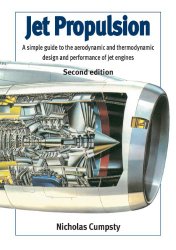 Jet Propulsion: A Simple Guide to the Aerodynamic and Thermodynamic Design and Performance of Jet Engines
Jet Propulsion: A Simple Guide to the Aerodynamic and Thermodynamic Design and Performance of Jet Enginesby Nicholas A. Cumpsty
Publisher: Cambridge Univ Press
ISBN: 0521541441
This text provides a self-contained introduction to the aerodynamic and thermodynamic design of modern civil and military jet engines. Through two engine design projects, the first for a new large passenger aircraft and the second for a new fighter aircraft, the author introduces, illustrates and explains the important facets of modern engine design. Individual sections cover aircraft requirements and aerodynamics, principles of gas turbines and jet engines, elementary compressible fluid mechanics, bypass ratio selection, scaling and dimensional analysis, turbine and compressor design and characteristics, and design optimization, as well as off-design performance. Although Cumpsty assumes familiarity with basic fluid mechanical ideas, he provides background where necessary.
The book emphasizes principles and ideas, with simplification and approximation used where this helps understanding. Many exercises and a detailed glossary support and reinforce the text. This book is suitable for student courses in aircraft propulsion and jet engine design and will be invaluable as a guide and reference for many engineers in the engine and airframe industry who are specialists outside the area of engine performance and overall aerothermal design.
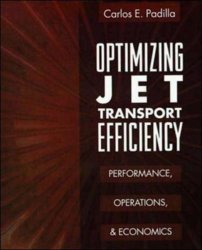 Optimizing Jet Transport Efficiency: Performance, Operations, and Economics
Optimizing Jet Transport Efficiency: Performance, Operations, and Economicsby Carlos E. Padilla, Russell Curtis
Publisher: McGraw-Hill Professional
ISBN: 007048208X
The definitive professional's reference to jet transport safety, efficiency, and profitability Modeled on airline training courses, this groundbreaking book thoroughly explores the driving maxim of jet transport design and engineering--carry as much weight as possible as far as possible as fast as possible at the greatest profit possible. Experienced performance engineer Carlos Padilla examines the key concepts and methods being used by today's TMS successful industry players to achieve this important goal.
This extensively researched volume provides you with important insights and heard-to-find information gained only through experience, including comprehensive explanations of performance issues related to jet operations. Featuring helpful lists and explanations of abbreviations and relevant terminology, this authoritative manual is also filled with example problems and solutions.
 Rocket Propulsion Elements
Rocket Propulsion Elementsby George P. Sutton, Oscar Biblarz
Publisher: Wiley-Interscience; 8 Edition
ISBN: 0470080248
Introduces the basic principles of rocket propulsion technology, liquid rocket engines, solid rocket motors, electric propulsion, and thrust vector control, with applications to space flight, satellite flight, and missiles. The seventh edition adds a chapter on liquid propellant thrust chambers, and sections on engine structures, gas properties, launch vehicles, design of turbopumps, and plume signatures.
Comprehensive and coherently organized, this seminal text guides readers evenhandedly through the complex factors that shape rocket propulsion, with both theory and practical design considerations. Professional engineers in the aerospace and defense industries as well as students in mechanical and aerospace engineering will find this updated classic indispensable for its scope of coverage and utility.
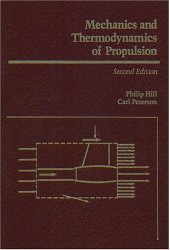 Mechanics and Thermodynamics of Propulsion
Mechanics and Thermodynamics of Propulsionby Philip Hill, Carl Peterson
Publisher: Prentice Hall
ISBN: 0201146592
In this textbook, the authors show that a few fundamental principles can provide students of mechanical and aeronautical engineering with a deep understanding of all modes of aircraft and spacecraft propulsion. The book also demonstrates how these fundamental principles can lead directly to useful quantitative assessments of performance as well as possibilities for improvement.
The second edition provides a wide range of new illustrative material on modern aircraft and rocket engines. The author s have also improved their explanations of pertinent physical phenomena and have introduced preliminary design procedures in this edition.
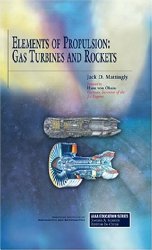 Elements of Propulsion: Gas Turbines and Rockets
Elements of Propulsion: Gas Turbines and Rocketsby J. Mattingly, H. von Ohain
Publisher: AIAA
ISBN: 1563477793
This text provides a complete introduction to gas turbine and rocket propulsion for aerospace and mechanical engineers. Building on the very successful Elements of Gas Turbine Propulsion, textbook coverage has been expanded to include rocket propulsion and the material on gas dynamics has been dramatically improved.
The text is divided into four parts: basic concepts and gas dynamics; analysis of rocket propulsion systems; parametric (design point) and performance (off-design) analysis of air breathing propulsion systems; and analysis and design of major gas turbine engine components (fans, compressors, turbines, inlets, nozzles, main burners, and afterburners).
 Frontiers of Propulsion Science (Progress in Astronautics and Aeronautics)
Frontiers of Propulsion Science (Progress in Astronautics and Aeronautics)by M. Millis, E. Davis
Publisher: AIAA
ISBN: 1563479567
"Frontiers of Propulsion Science" is the first-ever compilation of emerging science relevant to such notions as space drives, warp drives, gravity control, and faster-than-light travel - the kind of breakthroughs that would revolutionize spaceflight and enable human voyages to other star systems.
Although these concepts might sound like science fiction, they are appearing in growing numbers in reputable scientific journals. This is a nascent field where a variety of concepts and issues are being explored in the scientific literature, beginning in about the early 1990s. The collective status is still in step 1 and 2 of the scientific method, with initial observations being made and initial hypotheses being formulated, but a small number of approaches are already at step 4, with experiments underway.
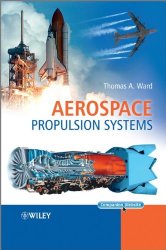 Aerospace Propulsion Systems
Aerospace Propulsion Systemsby Thomas A. Ward
Publisher: Wiley
ISBN: 0470824972
Aerospace Propulsion Systems is a unique book focusing on each type of propulsion system commonly used in aerospace vehicles today: rockets, piston aero engines, gas turbine engines, ramjets, and scramjets. Dr. Thomas A. Ward introduces each system in detail, imparting an understanding of basic engineering principles, describing key functionality mechanisms used in past and modern designs, and provides guidelines for student design projects.
With a balance of theory, fundamental performance analysis, and design, the book is specifically targeted to students or professionals who are new to the field and is arranged in an intuitive, systematic format to enhance learning.
 Gas Turbine Propulsion Systems
Gas Turbine Propulsion Systemsby Bernie MacIsaac, Roy Langton
Publisher: Wiley
ISBN: 047006563X
Major changes in gas turbine design, especially in the design and complexity of engine control systems, have led to the need for an up to date, systems-oriented treatment of gas turbine propulsion. Pulling together all of the systems and subsystems associated with gas turbine engines in aircraft and marine applications, Gas Turbine Propulsion Systems discusses the latest developments in the field.
Chapters include aircraft engine systems functional overview, marine propulsion systems, fuel control and power management systems, engine lubrication and scavenging systems, nacelle and ancillary systems, engine certification, unique engine systems and future developments in gas turbine propulsion systems. The authors also present examples of specific engines and applications.
 Computational Aeroacoustics: A Wave Number Approach
Computational Aeroacoustics: A Wave Number Approach Fundamentals of Physical Acoustics
Fundamentals of Physical Acoustics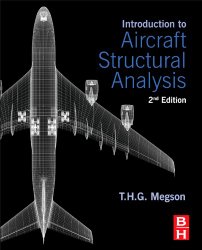 Introduction to Aircraft Structural Analysis
Introduction to Aircraft Structural Analysis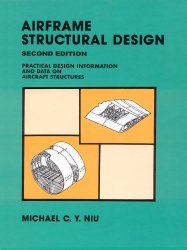 Airframe Structural Design: Practical Design Information and Data on Aircraft Structures
Airframe Structural Design: Practical Design Information and Data on Aircraft Structures Aeroelasticity: The Continuum Theory
Aeroelasticity: The Continuum Theory